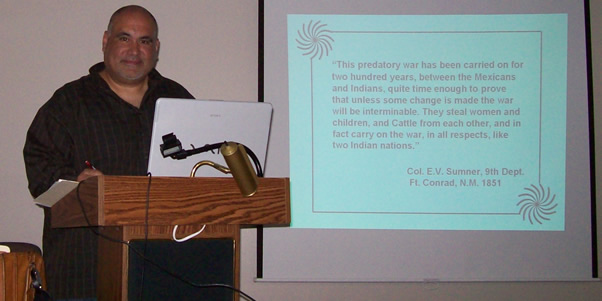Exploring Early American Policies
Professor Completes Research Fellowship on 19th-Century Indian Slavery
August 5, 2008
By Mimi Ko Cruz
Robert F. Castro, assistant professor of Chicana and Chicano studies, recently completed a research fellowship that focused on the enslaving of Mexican captives by American Indian raiders.
The fellowship, awarded by the Office of the New Mexico Historian, culminated with a lecture Castro delivered June 26.
His lecture focused on American policies aimed at prohibiting and abolishing the trafficking of Mexican captives in the U.S.-Mexico borderlands from 1848 to 1853. Castro discussed how post-war racial sentiments shaped enforcement protocols under the anti-captivity provisions of Article XI in the Treaty of Guadalupe Hidalgo.
"Captive-taking between Indians and Mestizos had become deeply rooted in borderland customs for more than 250 years before the United States annexed Southwestern areas as a result of the Mexican-American War in 1848," Castro told the audience of mostly scholars and students studying slavery, southwestern history and 19th-century race relations.
Article XI
The Treaty of Guadalupe Hidalgo's Article XI reads in part:
"It shall not be lawful, under any pretext whatever, for any inhabitant of the United States to purchase or acquire any Mexican, or any foreigner residing in Mexico, who may have been captured by Indians inhabiting the territory of either of the two republics; nor to purchase or acquire horses, mules, cattle, or property of any kind, stolen within Mexican territory by such Indians. And in the event of any person or persons, captured within Mexican territory by Indians, being carried into the territory of the united States, the Government of the latter engages and binds itself, in the most solemn manner, so soon as it shall know of such captives being within its territory, and shall be able so to do, through the faithful exercise of its influence and power, to rescue them and return them to their country."
"The U.S. had agreed to interdict the taking of Mexican captives by American Indians under Article XI in the Treaty of Guadalupe Hidalgo," he said. "American authorities soon realized that their expansionist agenda collided with the gritty realities of the trade.
"Ultimately, the failure of American officials to abolish captive-taking raids was inextricably linked to two principal causes. First, post-war racial sentiments led U.S. officials to erroneously believe that any effort, however minimal, would be sufficient to stop Indian raiding because the superior American pedigree would ultimately prevail against such 'barbarians.' Second, regional officials were unable to effectively translate the local manpower and resources they did possess into a comprehensive set of enforcement mechanisms. At all levels, U.S. officials fundamentally misunderstood and under-appreciated the complexities involving prestige, population and economic incentives that animated the captive-taking trade in borderland regions."
Castro, a resident of Chino, said his research "helps to provide a more comprehensive and complete understanding of how slavery, historically, functioned in America."
Through the New Mexico Historian Scholars Program, Castro also conducted research at that state's archival repositories.


